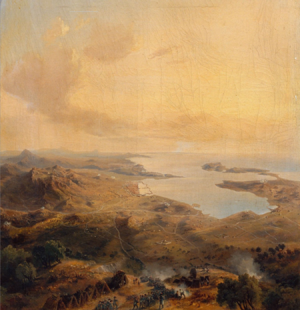Siege of Toulon (1793)
| Siege of Toulon | |||||||
|---|---|---|---|---|---|---|---|
| Part of the French Revolutionary Wars | |||||||
 The siege of Toulon by Jean-Antoine-Siméon Fort |
|||||||
|
|||||||
| Belligerents | |||||||
|
|
|
||||||
| Commanders and leaders | |||||||
|
|
|
||||||
| Strength | |||||||
| 32,000 |
about 22,000 |
||||||
| Casualties and losses | |||||||
|
2,000 dead or wounded, 15 captured |
about 4,000 dead | ||||||
about 22,000
37 British ships
32 Spanish ships
2,000 dead or wounded,
The Siege of Toulon (29 August – 19 December 1793) was a military siege of Republican forces over a Royalist rebellion in the southern French city of Toulon. It is also known as the Fall of Toulon.
After the arrest of the Girondist deputies on the 2 June 1793, there followed a series of insurrections within the French cities of Lyon, Avignon, Nîmes and Marseille. In Toulon, the revolutionaries evicted the existing Jacobin faction but were soon supplanted by the more numerous royalists. Upon the announcement of the recapture of Marseille and of the reprisals which had taken place there at the hands of the revolutionaries, the royalist forces, directed by the Baron d'Imbert, called for aid from the Anglo-Spanish fleet. On 28 August, Admiral Sir Samuel Hood of the Royal Navy and Admiral Juan de Lángara of the Spanish Navy, committed a force of 13,000 British, Spanish, Neapolitan and Piedmontese troops to the French royalists' cause. This was a serious blow to the arms of the republic, as it was a key naval arsenal of the country, with 26 ships of the line based there at the time (about one third of the total available to the French Navy). If France were to lose this port, there was no hope for her naval ambitions. Which would mean by proxy that any ambition to challenge the Allies, and specifically the British, for control of the seas would be out of the question. Not only that, but its loss could set a dangerous precedent for other areas that menaced the republic with revolt. The survival of the Republic was at stake. On 1 October, Baron d'Imbert proclaimed the young Louis XVII to be king of France, and hoisted the French royalist flag of the fleur de lys, delivering the town of Toulon to the British navy.
...
Wikipedia
